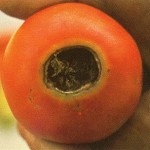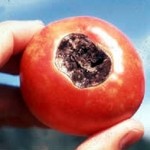San Antonio Express News
Gardening, ETC.
Sunday, May 28, 2006
By David Rodriguez
This time of the year many home owners become very concerned when they begin noticing the bottoms of their tomato fruit turning a dark wet color. This condition is called “Blossom-End Rot.” This is quite a common occurrence on tomatoes, but it can also occur on other crops such as squash, watermelon, eggplant, and peppers. Although, it may occur anywhere on the fruit, it generally occurs at the blossom end or bottom of the fruit. It can occur at almost anytime during the development of the fruit. It generally begins with the appearance of small, irregular-shaped water soaked areas near the base of the fruit which darkens and eventually can become leathery in appearance. When severe enough, it actually appears to wrinkle and can deteriorate as the fruit matures.
Why does blossom-end-rot occur? Researchers are not quite sure of the exact cause, but most agree it is associated with a deficiency of calcium as well as excessive water loss. One thing is certain-there are no pathogens associated with this occurrence. Fungus or other types of disease may infect the bottom of the fruit after the occurrence of blossom-end-rot, but these are secondary in nature.
Blossom-end-rot is a “physiological” disorder of tomato fruit. Conditions which favor its occurrence are those which result in water stress of the plant. These could be soils which are too wet, soils that are too dry or drying winds which increase water loss from the foliage. Whenever these conditions occur, the plants will lose more water to the atmosphere through its foliage than it can absorb through its roots. This will result in water loss from the plant and the fruit, resulting in a slight desiccation of the blossom-end or the bottom of the tomato fruit. These cells die, resulting in the appearance of the blackened area. This condition is aggravated when growing containerized plants since it is difficult to constantly maintain optimum soil moisture levels.
The visual symptoms associated with blossom-end-rot often are the result of a condition which may have occurred several days or even weeks prior to the symptoms. Therefore, when homeowners begin to worry about the occurrence of blossom-end-rot, the cause may have been several weeks prior to the conditions causing the problem.
What can be done about blossom-end-rot? It’s obvious that anything which will maintain uniform soil moisture will help. A vegetable garden located in a well-drained soil, will go a long way toward preventing the disorder which is associated with soggy or too wet soil. A good mulching program will also help as it reduces water loss from the soil and makes it more available to the plant during dry periods. A uniform and consistent watering program is also vitally important. Insuring a supply of readily available calcium will help prevent this problem. Currently, a yearly application of gypsum (calcium sulfate) at a rate of 3-4 lbs. per 100 square ft. or ½ cup per transplant at initial planting is now recommended even in our area’s highly calcareous soils.
One of the questions commonly asked is whether or not the affected fruit should be removed from the plant. There are those who feel that the fruit exhibiting blossom-end-rot should be left on the plant because if they are removed the problem will appear on other fruit. Others feel the fruit should be removed because the tissue can decay and serve as a source of severe diseases later on. These fruit will require nourishment from the plant to mature which could be utilized to produce top quality tomatoes. But by the same token, these fruits are still edible where the affected area is trimmed away, provided no secondary rot of the fruit occurs.
What should the homeowner do? The consensus of opinion among Texas horticulturists is that the fruit should be removed to allow for the development of top rate quality fruit rather than mature a fruit affected with blossom-end-rot. Locate the garden in a well-drained area of the yard, use a good mulching program, and maintain sufficient and adequate soil moisture for good growth.
The problem always seems worse than it really is because the “blossom-end rot” affected tomatoes are ALWAYS the first to ripen. Since we are hungry for fresh spring tomatoes, any blemish on the first precious fruit generates hysteria. In actuality, less than about 10 per cent of all fruit produced by an effected plant will be damaged. BE CALM, and make it simple. Blossom-end-rot can be simply eliminated by the removal of the effected fruit.
Special Event: Do you want to learn about growing citrus in San Antonio? Come visit Dr. Jerry Parsons on Thursday, June 8 at the Schultze House Brown Bag Lunch program at 12 noon in downtown HemisFair Park, 514 HemisFair Plaza. Have fun touring the cottage gardens too. Check it out!!!
Remember, Learn and Have Fun!
David Rodriguez is the County Extension Agent-Horticulture for Bexar County. He represents Texas Cooperative Extension with the Texas A&M University System. For any landscape or gardening information, call the Bexar County Master Gardeners AHotline@ at (210) 467-6575, email questions to mg-bexar@tamu.edu, or visit our County Extension website at http:bexar-tx.tamu.edu

